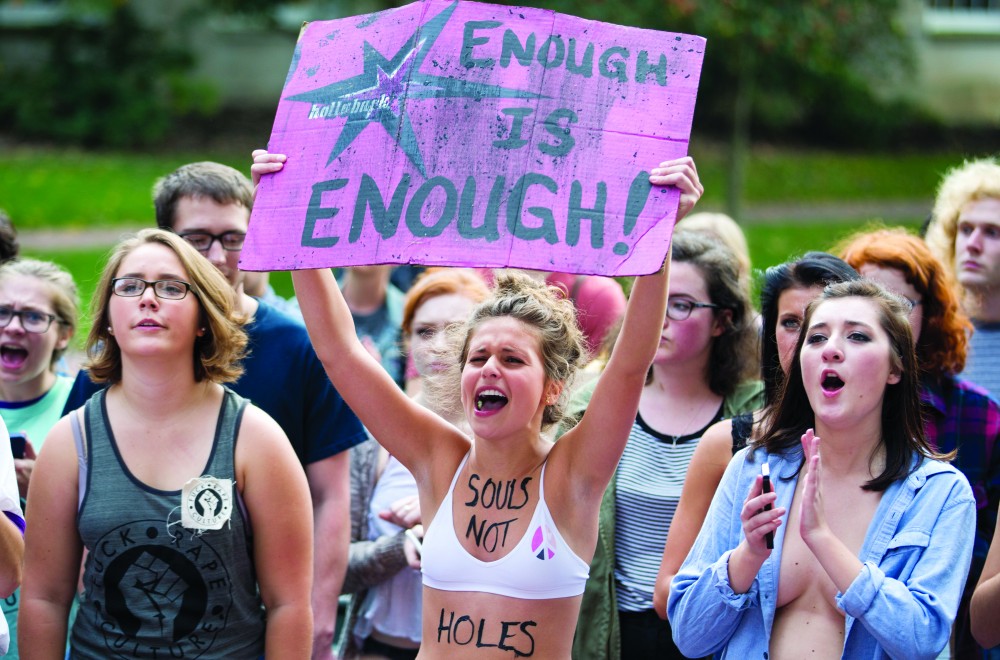Landing Page
Special Projects
This story is part of a series of specially designed stories that represents some of the best journalism The Post has to offer. Check out the rest of the special projects here.
03.08.18
The feminist movement helps women and their allies make strides toward equality.
“Feminism is the understanding that women are people,” Tess Hickey, a junior studying geography, said. “There are so many ways that women are disproportionately underprivileged and unequal to men.”
Hickey is referring to the patriarchal society, which is a male-dominated power structure prevalent on a societal level and within interpersonal relationships.

Mijana Mazur | FOR THE POST
The patriarchal society has sexism embedded in the political, social and economic spheres, according to Merriam-Webster. Feminist movements want to achieve certain goals that will give everyone fair treatment regardless of identities like gender, race or class.
Jaida Sterling, a junior studying journalism, said feminist movements have helped specific groups of people, such as women, people of color and LGBT individuals, achieve equal rights and earn their current place in society. Feminists need to work on including other groups of people because it would make solving issues easier, Sterling said.
“We’ve gotten far, but we’ve still got a ways to go,” she said.
Using an intersectional perspective allows people to see the intersections between different parts of a person’s identity such as race and gender, Hickey said.
“We need to be addressing and incorporating those groups in society who are the most oppressed due to the intersections of their identities,” she said. “If our feminism isn’t intersectional, then it’s not actually going to liberate everyone.”
Patty Stokes, an assistant professor in women, gender and sexuality studies, said the movement has made progress when it comes to reproductive rights because women have more options to control their fertility now.
Feminist movements have gained enough attention to make strides in demanding abortion rights, better access to contraception and more information on maternal health.
The ability to choose to have an abortion is often the main topic discussed because the public believes it’s the most important reproductive rights problem, according to the Center for Reproductive Rights.
Hickey said she is “pro-abortion,” an alternative to pro-choice, because it’s a stronger stance. Feminists who believe pro-abortion is a better approach don’t want people to be ashamed about choosing to abort a pregnancy.
The main women’s issue Hickey advocates against is sexual violence in light of the #MeToo and Time’s Up movements. Advocacy in past decades has strengthened the desire for affirmative consent. More recently, the anonymous account against actor Aziz Ansari for an uncomfortable sexual encounter has urged forth a change in how people view those situations.
Efforts have been restricted to social media and using hashtags to share experiences, but Hickey wants stronger actions against sexual assault and abuse.
Hickey disagrees with feminism that uses individual choices and lifestyle changes as a kind of political action because those methods often aren’t enough to create real change.
Sex-positive feminism focuses on destigmatizing the female body and can free women on an individual level without helping much else, she said. The “Free The Nipple” campaign is part of that sector, but it gained more attention through mainstream media and changed people’s opinions on female sexual liberation.
“That can feel very liberating, but I think it’s important to realize that that type of feminism … isn’t going to rid us of the extremely toxic, sexist culture that we live in,” Hickey said.
Stokes said most of the social issues concerning race, sex, gender and money can tie into feminism.
“I think it’s important to look at where struggle is really growing the most and where we can, as activists and as feminist activists, make those connections (between social issues),” she said.
Landing Page
This story is part of a series of specially designed stories that represents some of the best journalism The Post has to offer. Check out the rest of the special projects here.